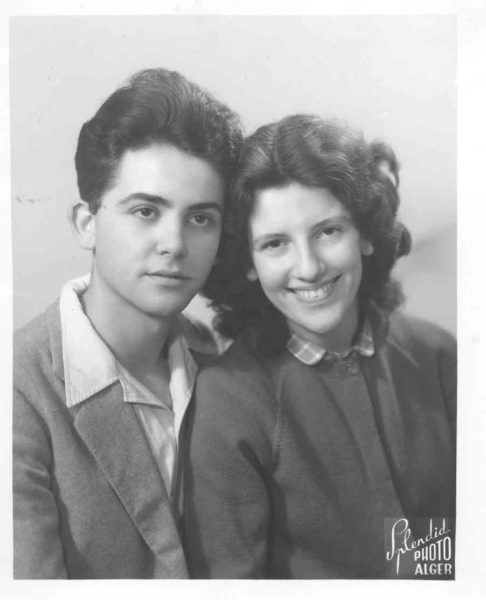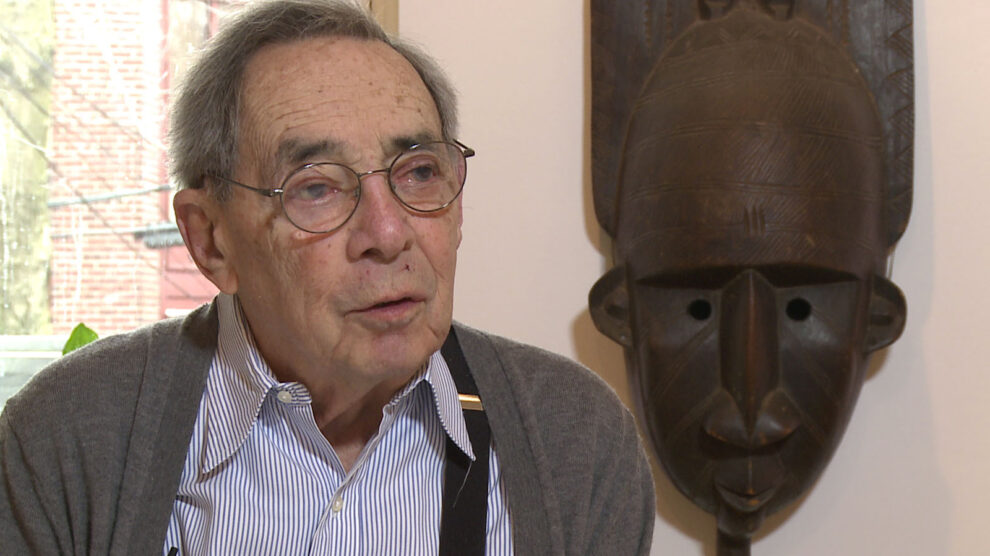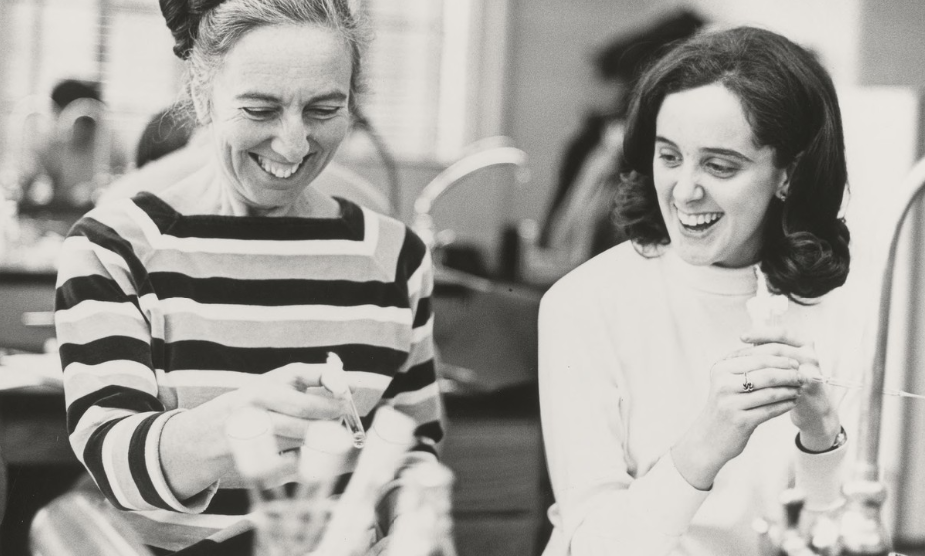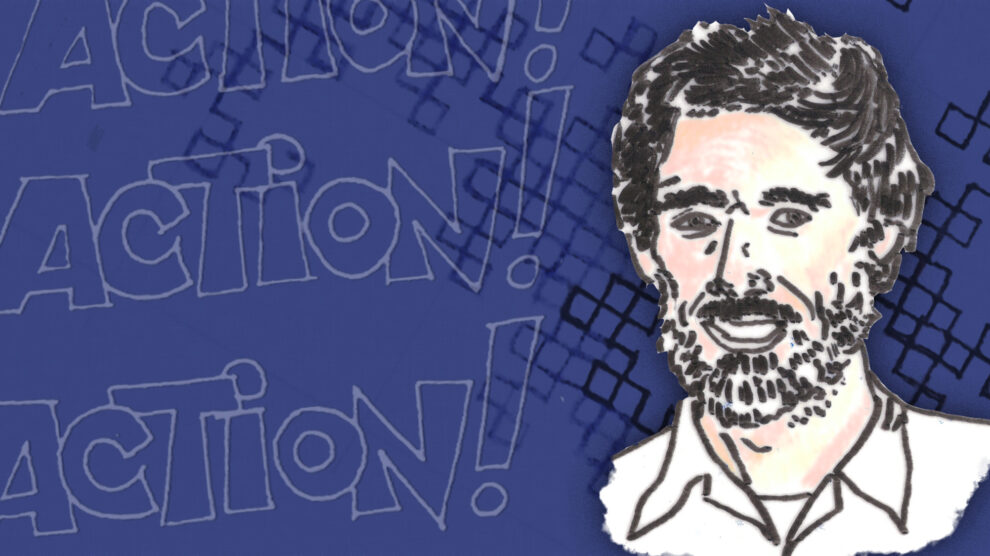Revolutionary Lives: Maurice et Josette Audin’s Battle for Algeria
By Michèle Audin
Volume 23, number 1, Science Under Occupation

On June 11, 1957, at 11 p.m., Maurice Audin, a twenty-five-year-old mathematician, was arrested at his home in Algiers.
Just over sixty-one years later, on September 13, 2018, at 2 p.m., Emmanuel Macron, the president of the French republic, visited Maurice’s widow Josette Audin, aged eighty-seven, at her home in Bagnolet, outside of Paris. He presented her with a presidential declaration acknowledging that Maurice Audin and many others had been tortured and killed, in application of the “arrest-and-detention” system legally instituted when the French colonial army had been entrusted with “special powers” in Algeria.1
Josette Audin was a retired math teacher. She taught in a few schools, first in Algiers (until 1966), then in France: one year in Étampes, then in Argenteuil, a Paris suburb. She and Maurice Audin met when both were math students at the University of Algiers and members of the Algerian Communist Party (PCA).
Josette’s father was a member of the PCA before her; there were no communists in Maurice Audin’s family. Another difference between them was the fact that she was born in Algiers to a family of “pieds-noirs”—the name given to European settlers in Algeria under French colonialism; Maurice’s father came from Lyon, in Metropolitan France.
Maurice Audin’s mother, Alphonsine Fort, on the other hand, came from a family of peasants of the Mitidja plain, near Algiers. At age fourteen she went to work as a maid for the young wife of a captain in the army; the captain’s personal adjutant was Louis Audin. Louis and Alphonsine married in 1923, left for Lyon, and started to live the—hard—life of workers during the Great Depression, experiencing unemployment and the deaths of three small children… To earn a living, Louis became a gendarme and was sent to the small city of Béja, in Tunisia. This is where Maurice Audin was born, on February 14, 1932.
The Front Populaire and its new colonial policies brought the French gendarmes and the Audin family back to France and Bayonne.2 A few years later the Second World War and the 1940 demobilization of French soldiers sent the family to Algiers, near Alphonsine’s parents. The Anglo-American troops invading French North Africa in 1942 occupied schools, making it difficult for children to study normally. The Audin parents decided to send their ten-year-old son to an army school. Maurice Audin spent four years at Hammam Righa, in Algeria, then from 1946 to 1948 went to school in Autun, in the center of France, far from his parents.3
He was a bright student; he loved math, much more than physical exercise and discipline. He obtained permission from his parents to come back to Algiers to prepare and pass his baccalauréat in 1949.
Here we should stop to take note of two roots of his political education. One was the martial discipline and atmosphere in the military school. Many of his fellow students dreamed of being given guns to shoot striking workers (there were many strikes in France in 1947-48, due to economic hardship and aversion towards the Marshall Plan). The other was the inhuman life of the indigenous Algerian farm workers employed by his mother’s peasant relatives.
By the end of his schooling, Maurice was a committed antimilitarist and anticolonialist. It is no wonder that he followed his fellow student (and future wife) Josette Sempé, and joined the PCA in 1951.
Josette also came from a modest family, where she was the very first to attend secondary school. She was good at Latin as well as math, and chose to study math upon entering the university.
So they were young, they were students and activists, and they were in love. René de Possel, a professor at Algiers University, became Maurice’s advisor, and found him a position as a teaching assistant. This allowed Josette and Maurice to begin their life together. Their (purely civil) marriage took place on January 24, 1953; a first child was born one year later.
And then came November 1, 1954, and the outbreak of the Algerian independence war, a rather unexpected development, as Josette would say later. The couple was deeply anticolonialist; they could not stand racial discrimination and the “blessings of colonialism” —like seeing how the indigenous shoeshine boys cleaned the shoes of the pieds-noirs instead of going to school. Of course they would promote independence. So would the PCA.
Their second child was born right after the banning of the PCA on September 13, 1955. Some party members joined the combatants of the National Liberation Front (FLN) in the mountains and took part in the armed struggle. The FLN wanted the party to disband and its members to join the Front. The leaders of the party went underground instead. Maurice’s task was to take care of them. For instance, in September 1956, he helped smuggle Larbi Bouhali, the PCA’s General Secretary, out of Algiers in the cabin of a French Communist sailor on a cargo ship bound for China.
At the same time, Maurice was writing his thesis on linear mappings between topological vector spaces. He had already published a few preliminary notes in a French journal, some of the first steps in a branch of mathematics that would soon become mainstream. At the end of 1956, he flew to Paris where he met Laurent Schwartz, Henri Cartan, and Gaston Julia, among other prominent mathematicians. He outlined his work to Schwartz, and they started to plan a thesis defense in Paris for the following year (1957). From this time on, Schwartz considered Maurice to be one of his students.4
But the following year came the Battle of Algiers. The war had started in the mountains and had now reached the city, where the FLN organized attacks against French civilian targets. Using the special powers granted by the French National Assembly to the government on March 12, 1956, full police powers were granted to the army, more specifically to the 10th RCP (Régiment de Chasseurs Parachutistes)—eight thousand paratroopers, under the command of General Massu. Their method was to use torture, more in order to terrorize the people than to obtain information.5
Josette and Maurice Audin had their third child in April. Paul Caballero, the party secretary who replaced Larbi Bouhali, was living with Maurice’s sister and her family, who got worried when their guest fell ill. Maurice took charge of Caballero; he called a Communist doctor, who came to Maurice and Josette’s home and cured the patient.
Unfortunately, the doctor was arrested and spoke under torture. The soldiers quickly moved to arrest Maurice. His family never saw him again.
The French authorities set a trap in the apartment: two of the soldiers who arrested Audin stayed overnight. Josette Audin was not allowed to leave nor to use the phone. The next day, the Communist journalist Henri Alleg was arrested there. He was the former director of Alger Républicain and a bigger catch than Maurice Audin. He was tortured in prison and later reported, in his book La question, that Maurice Audin was tortured as well. Josette Audin and her three young children spent a few days confined in the apartment with soldiers before she could go out and seek news of Maurice.6
This marked the beginning of what the historian Pierre Vidal-Naquet called the “Audin Affair.”7
When she overheard the soldiers speaking of Maurice in the past tense, Josette Audin knew with certainty that her husband was dead. And this was soon confirmed by their subsequent claim that he had escaped detention and disappeared without a trace.
Many people disappeared during the Battle of Algiers, in similar ways—three thousand, according to some estimates.8
Maurice Audin’s singularity was the fact that he and his wife were intellectuals, that Josette was able to write and send letters. And this is what she did. She met lawyers and journalists and sent hundreds of handwritten letters. Of course she started with Laurent Schwartz, Maurice’s thesis advisor. But she wrote “to everybody” of Maurice’s arrest and the actions she wanted to undertake, to those who had written about torture in the newspapers, to help her get answers about the disappearance of her husband. Among these was the young historian Pierre Vidal-Naquet.
When Josette Audin’s first letter (dated June 20, 1957) reached Schwartz, he was visiting Bombay. Back in Paris, he began to mobilize his colleagues at the University of Paris. At his instigation, the Council of the Faculty of Sciences adopted a resolution containing the sentence: “It is unacceptable that, in today’s France, somebody can be arrested, and four months later, it still be impossible to know what happened to him.”9 Schwartz decided to organize a defense of Maurice Audin’s thesis in absentia. This took place in a large auditorium at the Sorbonne on December 2, 1957. Jean Favard, who chaired the committee, asked whether Maurice Audin was present in the room. Then René de Possel presented his student’s work, entitled “On Linear Equations in a Vector Space.” After the meeting of the committee, Maurice Audin was awarded the title of doctor. The many listeners observed a moment of silence. Josette Audin was present, with her parents-in-law, Louis and Alphonsine.
Pierre Vidal-Naquet—a teaching assistant, like Audin, at the University of Caen—soon began investigating the military’s story of the escape. With the help of Jérôme Lindon, the publisher of the Éditions de Minuit and of Henri Alleg’s La question, he wrote up his conclusions in the booklet L’Affaire Audin, which appeared in May 1958 and shattered the official story.10
Following the lead of Schwartz and Vidal-Naquet, many “Audin committees” were organized, especially at the universities, starting a large mobilization of professors and students against torture—and against the war—in Algeria. Two decades later, still with Schwartz as a leader, a French “committee of mathematicians,” inspired by the Audin case, would obtain the liberation of mathematicians Leonid Plyushch from a Soviet mental asylum, and José Luis Massera—like Maurice Audin, a communist activist—from a jail in Uruguay.11
Algeria became independent in 1962. A French law granted amnesty for any act committed in France in relation to the Algeria war.
The publication of Vidal-Naquet’s booklet was followed by sixty years of protests, demands, claims, petitions, and various trials, including a lawsuit for crimes against humanity, which Josette lost. The official version was still that Maurice Audin had escaped. Historical research on the Algeria war expanded during that time. Works by Raphaëlle Branche and Sylvie Thénault, to name a few, highlighted the arrest-and-detention system and the intensive use of torture by the French army.
In June 2014, President François Hollande took the first step, acknowledging that Maurice had died in detention. This small step, after fifty-seven years, was a big disappointment for Josette Audin.
It is very rare that the official version of a fact is so far from the historical truth—this was noted during the preparation of president Macron’s September 2018 declaration, which now finally acknowledges France’s responsibility for the death of Maurice Audin.
However, as Josette immediately objected when she read the declaration two days before the President’s visit, even this text does not tell precisely how Maurice Audin was killed. Using Schwartz’s words, sixty-one years later, it is still impossible to know what happened to him.
Quite a few theories have been formulated on this point. Vidal-Naquet suggested that Maurice was strangled by Lieutenant Charbonnier during questioning under torture—unfortunately he did not give his source. Colonel Godard wrote somewhere (in a manuscript found by the journalist Nathalie Funès) that Maurice was executed, that this was a mistake, the victim should have been Henri Alleg—but the two men were very dissimilar, and Godard’s motivation may have been to place the blame on General Massu. According to a posthumous revelation from an interview with General Aussaresses, Audin was executed to make an example—but why work so hard to conceal a death which was supposed to be an example?
The President’s 2018 declaration invites those who have information about what happened to make their knowledge public. But sixty years have gone by, and the investigation and interviews published by the journalist Nathalie Funès and the historian Sylvie Thénault, among others, offer little hope that “the truth” will ever be known.12
Josette Audin died on February 2, 2019, less than five months after she won her battle.
About the Author
Michèle Audin was born in 1954 in Algiers. She is a French mathematician working on symplectic geometry. She was professor at Strasbourg University. She is also a writer and has published several novels, notably Une vie brève (about her father Maurice Audin), Cent vingt et un jours (published in English as One Hundred Twenty-One Days by Deep Vellum), and Comme une rivière bleue (about the 1871 Paris Commune). She is interested in history, literature, and their relationship.
References
- Quotation from the presidential declaration of Emmanuel Macron on the death of Maurice Audin.
- People’s Front, a left-wing coalition government of the Socialist, Communist, and Radical Socialist Republican parties, was elected to office in France in May 1936.
- Michèle Audin, Une Vie brève (Paris: L’Arbalète-Gallimard, 2013).
- The Comptes rendus notes, Schwartz’s book.
- Magalie Besse, Sylvie Thénault, eds, Réparer l’injustice: l’Affaire Maurice Audin 22 (Institut Francophone pour la Justice et la Démocratie, 2019).
- Henri Alleg, La question (Paris: Les Éditions de Minuit, 1958).
- Pierre Vidal-Naquet, L’Affaire Audin (Paris: Les Éditions de Minuit, 1958).
- Estimate of Paul Teitgen, quoted in Yves Courrière, La Guerre d’Algérie, tome 1, 1954-1957 (Documents), (Paris: Fayard, 2001).
- Audin family archives, held at École Polytechnique (Paris, France).
- Pierre Vidal-Naquet, L’Affaire Audin.
- Besse and Thénault, eds., Réparer l’injustice.
- Nathalie Funès, Le camp de Lodi: Algérie, 1954-1962, (Paris: Stock, 2012).





